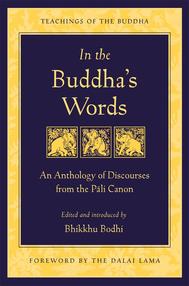Ancient Buddhist Scriptures
Everything we teach comes from the ancient sermons taught by Gautama Buddha and his enlightened disciples that lived with him. They have been preserved in the Sutta Pitaka by the Theravada Buddhist tradition.
Shortly after the Buddha passed away, 500 fully enlightened monks gathered at the First Great Council to recite all of the sermons they remembered that the Buddha and his enlightened disciples preached. They then organized them into five collections known as Nikayas. Groups of monks were assigned to memorize these collections and get together frequently to recite them. At the time in India there was a strong tradition of memorization like this among members of the Brahmin caste. Eventually because of dangers such as war and famine, there was the fear that there would not be enough monks alive to keep up this tradition, so the sermons were written down in the original language of Pali. The translations we have today are from these texts.
The Nikayas have a variety of styles of text. Some are stories, some are regular sermons. Some are highly analytical teachings, and some are collections of verses. Some of the Nikayas are organized by topic. Others are organized by length of text. We are very fortunate that all of them have been translated into clear, modern English within the last 30 or so years.
Below you can see an outline of the books that make up the Sutta Pitaka as well as titles of translations into simple English.
Shortly after the Buddha passed away, 500 fully enlightened monks gathered at the First Great Council to recite all of the sermons they remembered that the Buddha and his enlightened disciples preached. They then organized them into five collections known as Nikayas. Groups of monks were assigned to memorize these collections and get together frequently to recite them. At the time in India there was a strong tradition of memorization like this among members of the Brahmin caste. Eventually because of dangers such as war and famine, there was the fear that there would not be enough monks alive to keep up this tradition, so the sermons were written down in the original language of Pali. The translations we have today are from these texts.
The Nikayas have a variety of styles of text. Some are stories, some are regular sermons. Some are highly analytical teachings, and some are collections of verses. Some of the Nikayas are organized by topic. Others are organized by length of text. We are very fortunate that all of them have been translated into clear, modern English within the last 30 or so years.
Below you can see an outline of the books that make up the Sutta Pitaka as well as titles of translations into simple English.
|
The following are the books that contain the original teachings of the Buddha. These are the translations we recommend.
Dīgha Nikāya, Long Discourses (D or DN): Contains 34 suttas that range in length from 5 to 47 pages.
Khuddakapāṭha (Khp): This is a collection of 10 suttas.
Dhammapada (Dhp): This is a collection of 423 short verses, grouped into 26 chapters. This is an excellent text for newcomers and experienced practitioners alike. It takes about 4 minutes to read one chapter so it is well suited to someone with a short amount of time available. Even just reading a single verse each day will instill your life with the Blessed One’s wisdom.
Dīgha Nikāya, Long Discourses (D or DN): Contains 34 suttas that range in length from 5 to 47 pages.
- The Long Discourses of the Buddha: A Translation of the Dīgha Nikāya by Maurice Walsh, Wisdom Publications.
- The Middle Length Discourses of the Buddha: a Translation of the Majjhima Nikaya, translated by Bhikkhu Ñāṇamoli, edited by Bhikkhu Bodhi, Wisdom Publications.
- The Connected Discourses of the Buddha: A Translation of the Saṁyutta Nikāya, by Bhikkhu Bodhi, Wisdom Publications.
- Two sections have bee published individually: Stories of Sakka, Lord of Gods, and Stories of Brahmas.
- The Numerical Discourses of the Buddha: A Translation of the Aṅguttara Nikāya, by Bhikkhu Bodhi, Wisdom Publications.
Khuddakapāṭha (Khp): This is a collection of 10 suttas.
Dhammapada (Dhp): This is a collection of 423 short verses, grouped into 26 chapters. This is an excellent text for newcomers and experienced practitioners alike. It takes about 4 minutes to read one chapter so it is well suited to someone with a short amount of time available. Even just reading a single verse each day will instill your life with the Blessed One’s wisdom.
- Dhammapada, translated by Venerable Acharya Buddharakkhita.
- The Dhammapada : teachings of the Buddha, by Gil Fronsdal
- The Udāna and the Itivuttaka, Two Classics from the Pali Canon, translated by John D. Ireland, Buddhist Publication Society (BPS) Complete text.
- The Udāna and the Itivuttaka, Two Classics from the Pali Canon, translated by John D. Ireland, Buddhist Publication Society (BPS) Complete text.
- The Group of Discourses (Sutta-nipāta), by K.R. Norman
- Stories of Heavenly Mansions
- Stories of Ghosts from the Petavatthu
- Voice of Enlightened Monks: Theragata
- The Voice of Enlightened Nuns: Therigata
- Jataka Tales of the Buddha: An Anthology, Volume 1-3, by Ken Kawasaki and Visakha Kawasaki. This is a selection of the stories.


